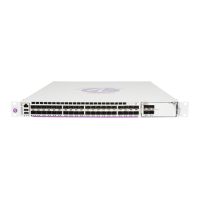Port Features
Page 76 7750 SR Interface Configuration Guide
APS Switching Modes
APS behavior and operation differs based on the switching mode configured for the APS group.
Several switching modes are supported in SR-OS.
The switching mode affects how the two directions of a link behave during failure scenarios and
how APS tx operates.
Unidirectional / Bidirectional configuration must be the same at both sides of the APS group. The
APS protocol (K byte messages) exchange switching mode information to ensure that both nodes
can detect a configuration mismatch.
• If one end of an APS group is configured in a Unidirectional mode (Uni 1+1 Sig APS or
Uni 1+1 Sig+Data APS) then the other end must also be configured in a Unidirectional
mode (Uni 1+1 Sig+Data APS).
• If one end of an APS group is configured in a Bidirectional mode then the other end must
also be configured in Bidirectional mode.
The support of switching modes depends on SC-APS / MC-APS, MDAs, port types and encaps.
For a definitive description of the MDAs, port types, switching modes, bundles and encapsulations
supported with APS, see APS Applicability, Restrictions and Interactions on page 90.
Table 17: APS Switching Modes
Bidirectional 1+1
Signalling APS
Unidirectional 1+1
Signalling APS
Unidirectional 1+1
Signalling and
Datapath APS
Short form name Bidir 1+1 Sig APS Uni 1+1 Sig APS Uni 1+1 Sig+Data APS
CLI keyword bi-directional uni-directional uni-1plus1
Interworks with a standards
compliant APS
implementation
Yes Yes Yes
Full 1+1 APS standards-
based signalling
Yes Yes Yes
Data is transmitted
simultaneously on both links/
circuits (1+1 Data)
No No Yes
